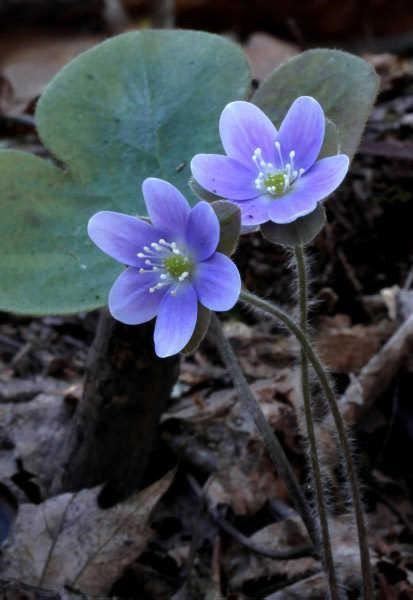The Silent One
If you are like me, and love plants, you definitely have your favorites. Hepatica and I have been friends ever since I saw them for the first time outside limestone caves of Santee State Park in South Carolina. My Uncle Munsy turned me on to the caves, but the flowers kept me coming back every year to catch up. Each year I would monitor the population, but mainly I would just sit, visit, and admire. (Caution: Granola-head statement ahead!) Hepatica, with its amazing color and presence, made me feel it was sentient and had something to tell me. I know how that sounds, but it just resonated with me, and I sat for a long time with them each year.

The Chippewa Indians called the plant gabisanikeag, which meant “it is silent.” I liked that name when I read it; it felt right somehow, like they exactly caught the plant’s personality. I know you might be thinking I am not just a plant lover but a flower child. Seeing that I only lived three years in the sixties, it is a stretch. On the other hand, perhaps that is all it took in those heady times. Nonetheless, I liked Hepatica so much that I wrote poetry about them. I am, I assure you, valiantly trying to refrain from sharing.
Ephemeral flowers found at Umstead State Park such as Hepatica, Trout Lily, Windflower, Bloodroot, and Pennywort harken the lengthening daylight and seem designed to lift our spirits after winter. Their lifestyle, however, is rather down and dirty, to flower before the trees leaf out, so they take advantage of the late winter and early spring sunlight to photosynthesize and build up stores of carbohydrates in their roots to last another year.
Spring ephemerals, however, cannot count on insects for fertilization due to the cold weather they often endure, so most of them, if not all, can self-fertilize. These ephemerals evolved with ants in a relationship called myrmechory. The seed of many ephemerals have elaisosomes, which is a nutritious addition on the end of the seeds that ants will take into their anthill and eat, discarding the rest of the viable seed on a trash heap, which provides a fertile and friendly place for a plant to start as well as giving seed predators less access to the seeds.
Hepatica and other ephemerals are found throughout the park, and a searching eye will find them on the stream banks or moist areas. If you need help finding them, I will guide you to them. If you don’t take to them like I did, I will try not to think less of you, but if that is indeed the case, it may be time for some serious introspection on your end.
I fought against adding the poem, but it overpowered me. Circa August 1997, and before I knew its name. The silent one. I will ask my parents if we have some Chippewa blood.
From the cave flows a clear cold stream
With high banks growing and guarding the little green
Sentinels that signal Winter’s end.
They sing in whispers, slow but sure
Gently tickling my ear and spirit
The feather soft song of the Hepatica.
Gently blue, not quite of the sky
For wood wanderers and elves to know
Patience and many returns reward me
This bringing of spring to the land and my heart.
And from heart to you, and you, and you
The beautiful silent sharing.
The beautiful silent singing
The cloud soft song, of the Hepatica
Know more to see more,
Ranger Billy
